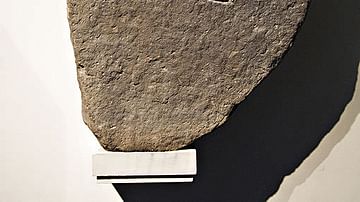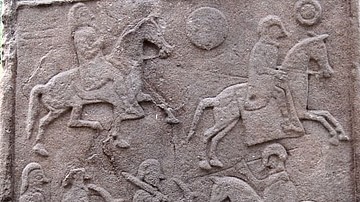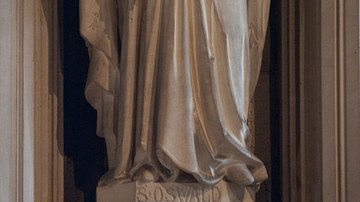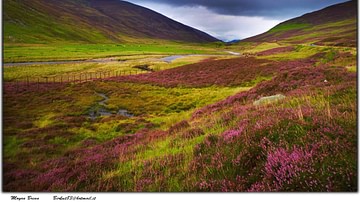
Drust I (also known as Drest I, Drest son of Irb, and Drest son of Erb) was an early king of the Picts known as "The King of One Hundred Battles" that he seems to have been victorious in. His reign is given as 406-451 CE, 413-451 CE, 424-451 CE, 432-451 CE, or 424-453 CE ,and his lifespan as 407-478 CE, depending on which of the primary sources one accepts. The Picts themselves left no written records of their history, only cut stones, or stones in situ, carved with images, and so their story, even their king's list, was written by the Romans and, later, by Scottish and English historians. It was under Drust I's reign that Christianity was first introduced to the Picts by St. Ninian (360-432 CE) who first arrived in the region in 397 CE (though this is contested). It has also been recorded that it was in the nineteenth year of Drust I's reign that St. Patrick left Scotland for Ireland, which was in 432 CE, arguing for a date of 413 CE as the start of his reign, and 451 CE as the date of his death. This is most probably the correct date Drust I's rule but it is by no means certain.
The authors of the early chronicles were primarily interested in dating the success of Christian missionary work in Northern Britain, not with Pictish history, and their works mention Drust I only as a means of establishing when which missionary was at work in which region. The historian Stuart McHardy has noted that one must be careful in accepting ancient sources on Pictish history without question because none of these histories were written by the people themselves and, usually, these sources cite the Picts as a means to further their own narrative ends. He writes, "As we have no contemporary literary Pictish records we are constantly forced to deal with material that has to be treated carefully. The truism that history is written by the winners might be better expressed as history is re-written by the winners" (118). However Drust I might have welcomed, or resisted, the Christian missionaries to the Picts is unknown, and the evidence of later conflicts between Picts trying to maintain their traditional beliefs and Christian missionaries sheds no light on the period of Drust I's reign.
The Role of the Chief & Rise of Kingship
The Picts lived in small communities made up of families belonging to a single clan (known as a "kin"), which was presided over by a tribal chief. These clans were known as Caerini, Cornavii, Lugi, Smertae, Decantae, Carnonacae, Caledonii, Selgovae and Votadini (McHardy, 31). These clans often raided each other for cattle, but banded together when threatened by a common enemy and elected a single chief to lead the coalition. The kin (which comes from the Gaelic word for "children") would continue to follow and protect their chief but that chief would obey the warrior all had agreed upon as group leader. Regarding the role of the chief, the historians Peter and Fiona Somerset Fry write:
The head of the kin was a very powerful man. He was looked upon as father of everyone in the kin, even though he might only be a distant cousin to most. He commanded their loyalty: he had proprietary rights over their land, their cattle; their possessions were in a sense his. His quarrels involved them and they had to take part in them, even to the point of laying down their lives (33).
The role of the chief, and how the Picts would set aside their tribal differences in times of external threat, is first illustrated through the Roman writer Tacitus' account of the Battle of Mons Graupius in 83 CE between the Roman forces under Agricola and the Picts united under the Caledonian chief Calgacus. In 79/80 CE Agricola invaded Scotland and pressed on to a line between the rivers Clyde and Forth by 82 CE. After establishing fortifications, he then invaded the land of the Picts in 83 CE and was met by Calgacus in battle at Mons Graupius.
Tacitus recorded the battle and, in so doing, was the first to give a written account of Scottish history. It is from Tacitus' account of this battle, and Calgacus' famous speech to his men, that the phrase, "They make a solitude and call it peace" comes. Tacitus does not call Calgacus a king nor a chief but writes, "One of the many leaders, named Calgacus, a man of outstanding valour and nobility, summoned the masses who were already thirsting for battle and addressed them." McHardy notes that Calgacus "appears to have held his role on account of his skill rather than any supposed particular birthright or aristocratic position. This again is echoed in later clan society where each clan had its own captain who led them into battle" (McHardy, 28). The chief of the clan, and the tribal system, changed owing to the influence of Christianity among the Picts and the rise of the Anglican Kingdom of Northumbria which was governed by a monarchy.
Christianity changed the Pictish system of government by replacing the Pict's matrilineal system of succession (in which leadership descended from the mother's side) with a patrilineal system, in which the eldest son succeeded his father. This seems to have occurred when the Pict's devotion to a Mother Goddess was replaced by the patriarchal male God of Christianity. The Angles of Northumbria's influence in the Picts, as far as the tribal chief being replaced by a monarch, had to do with their repeated incursions into Pictish lands which necessitated strong central leadership in the form of a king of all the tribes reigning consistently instead of the old system of many tribal chiefs who banded together under one leader when necessary. Although it is unclear why the Picts felt the need for a central government, it is thought that they may have attributed the Northumbrians' effectiveness in conquest to their kings and so sought to protect their lands by mirroring the Angle's form of government (though this is hardly certain). The first king of the Picts was Gede, though no years are given for his reign but, by the time of Drust I, the kingship seems to have become an accepted position among the Picts as it is mentioned by ancient chroniclers without comment or explanation.
The Reign of Drust I
Very little is known of Drust I's reign. He is mentioned in a number of ancient histories including The Chronicle of the Ancient Picts which is a work of Pictish history by an unknown author set down sometime in the reign of Kenneth II of Scotland (971-995 CE). Regarding Drust I's mention in the Chronicles, the 19th century CE historian Thomas Innes writes: "The old records of St. Andrews have it in these words: 'Drust or Durst, fil. Urb or Irb, 100 an. vixit, and 100 bella peregit' meaning 'Drust son of Irb lived 100 years and fought 100 battles'" (90). Innes concludes that Drust I's reign began in 406 CE and ended in 451 CE based upon information from sources which he does not provide. He then writes:
By this calculation it appears that it was during the reign of this Drust (Durst) that the gospel was first preached to the Picts by St. Ninian, in the beginning of the fifth century, and afterwards by St. Palladius and St. Patrick to the Scots and Irish, betwixt A.D. 430 and 440. And here ends the first part of the abstract of the Pictish Chronicles, which contains the account of the succession of their kings in the times of ignorance preceding their conversion to Christianity, when, it is like, they first received the use of letters (90).
Aside from his simply being part of the Christian narrative of the conversion of the Picts, Drust I seems to have been a formidable military leader and effective king of his people. Writing in 1794 CE, the historian John Pinkerton, in his work An Enquiry Into the History of Scotland Preceeding the Reign of Malcolm III or the Year 1056, notes that Drust was well known for the battles he fought and his devotion to the freedom of his people. The "100 Battles" mentioned by Innes, and others, seem to have been offensive engagements to keep southern tribes from the lands of the Picts; aggressive campaigns to either hold or expand Pictish territory in the face of encroachments by Angles, Britons, and Scots. Pinkerton mentions the Romans in his narrative and seems to be following the same source as Innes did in his later 1879 CE work regarding the approximate length of Drust I's reign. It is Pinkerton who sets the beginning of Drust I's rule at 413 CE based upon the year St. Patrick left Scotland for Ireland (432 CE in the 19th year of Drust I's reign). As the Romans left Britain in 410 CE, and had long before abandoned their attempts to conquer the northern lands of the Picts, it seems unlikely that King Drust I of the Picts would have had any engagements with the legions of Rome. As with most of Drust I's life, however, this is as certain as the dates of his reign.
Drawing on the ancient Chronicles and Annals, Pinkerton writes:
The Pictish monarchy, anciently confined to the Hebud Isles [the Hebrides], was by degrees extended over the northwest of Pictland, or present Scotland; and Drust, who begins this series, seems to have employed some of his battles in spreading it all over Pictland. For in the next century we find Bede mentions Brudi II as king of all the Picts without any hint that the title was new. The reign of Drust is remarkable, and illustrious, in many respects; from Christianity being established among the Southern Picts in, or just before, his time; from the rude praise, that he fought a hundred battles; from the frequent incursions of the Picts, and their seizing on Valencia, when the Romans left the island. Hence the epithet of `Great' seems his due; and is often given with less cause...The Pictish Chronicle says it was in the xix [19th] year of Drust's reign, that St. Patrick went to Ireland. Usher [another historian] shows that it was in 432, that event happened; which forms a fixed epoch for the commencement of this reign [413]. Drust is said to have fought an hundred battles, that is, a great number; many of them perhaps to establish his authority over the Southern Picts and many, no doubt, against the Britons and Romans, the latter of whom left the island (295).
Drust I, then, appears to have been the first Pictish king to expand his kingdom over all of Northern Britain in contrast to earlier chiefs, and then kings, who seem to have been content to rule over their tribal lands. It should be noted, however, that there is no reliable information on the kings who preceded Drust I. The artist and historian of the Picts, Ronald W. Henderson, of Perth, Scotland, notes that, "We have no information [on the kings before Drust I] apart from their names and supposed lengths of reign...other writers have made various suggestions as to their meanings but mostly without much sign of success. the names are just too obscure" (22). Drust I is then the first king who was notable enough to have been written about.
Henderson dates Drust I's birth date to 407 CE, "when the Romans were leaving Britain" and characterizes him as a man who "probably became a legend in his own lifetime...A true leader, he took control during the ensuing disruption [of the Roman evacuation] and united all the Southern Picts under his banner, (which probably depicted a wild boar), and is thought to have set up safe harbours to protect his coastline from invasion by the Britons" (22). Henderson goes on to state:
What is believed to be his fort, known as Trusty's (i.e. Drust's) Hill, lies at Anwoth near Gatehouse of Fleet in Galloway in Southwestern Scotland. The ruins of this fort still exist, along with Pictish symbols comprising a double disc and `Z' rod, a sea serpent, a geometric symbol which it has been suggested looks like a dagger, and what appears to be an insect's head, all carved on an outcrop of rock near the fort's entrance (22).
Further evidence of Drust I's reign, according to Henderson, is the fresh water spring Katie Thirsty Well south of Abnernethy, Scotland. Henderson points out that the well is not called "Katie's Thirst Well" nor is it "Katie Thirsty's Well" but Katie Thirsty Well and argues that the origin of the name comes from St. Katherine of Alexandria (who was martyred) attached to a corruption of Drust's name, `Trusty' (as with `Trusty's Hill') to become `Thirsty'. Henderson therefore rejects the better known story of the origin of the name that a maid named Katie Thirsty regularly used the well to fetch water for her mistress, Lady Miller, for an illegal still she had. The probability that Henderson is correct in his claim is strengthened by the known correlation between the names `Drust', `Drustan' and `Trust', `Trustan', and `Tristran'/`Tristram'. As Trusty's Hill is identified with Drust I, so may the well be which originally could have been called either Katherine's Well or Drust's Well before the names combined into Katie and Drust's Well to finally become Katie Thirsty Well.
That Drust I was an important figure in Pictish history is recognized by the number of times his name appears in later chronicles as the "King of One Hundred Battles" and, as noted, for his success in expanding the territory of the Picts. Unfortunately, the ancient historians who were not just using Drust's reign as a marker for Christian missionary efforts, either wrote in the belief that Drust I was famous enough to require no elaboration on his reign or such documentation has been lost. Drust I's death date, according to Henderson, is 478 CE, much later than that usually given (as is the birth date of 407 CE) and this discrepancy epitomizes the difficulty in making any definite assertions about the reign of King Drust I other than that he was known for the length of his life and his numerous military victories.
Although, as noted, he is almost always cited as the king under whom Christianity came to the Picts, it is also claimed that this event happened before, or after, his reign. After Drust I died, rule passed to Tholarg son of Anile and then to Nechtan Morbet son of Irb (most likely Drust I's younger brother), and Nechtan is also credited as the king who welcomed the Christian missionaries. Nechtan's reign, c. 485 CE, is too late, however, for St. Ninian's missionary work and too early for St. Columba's. While there were certainly Christians at work evangelizing the populace between Ninian and Columba, these two are the best known and most often cited in conjunction with other events in order to record their successes. It is therefore probable - though not certain - that it was Ninian's efforts under Drust I which first brought Christianity to the Picts. However that may be, Drust I of the Picts has long been recognized as an important military and political figure of 5th century CE Scotland, even if the particulars of his victories and accomplishments have now been lost to time.




